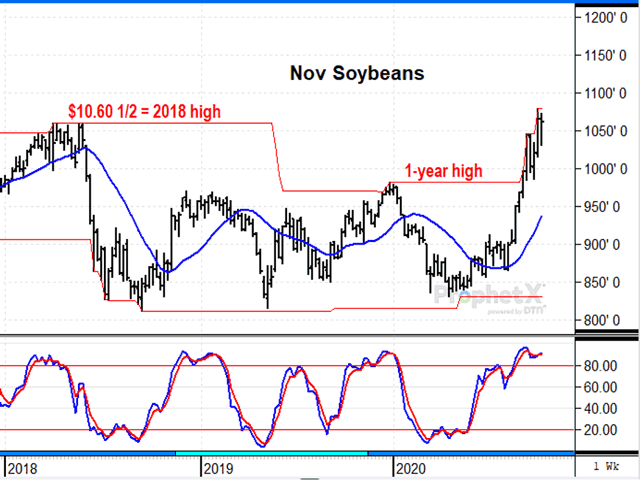Todd's Take
The Dilemma of High Soybean Prices
Back in late April when November soybeans fell as low as $8.31 a bushel, an offer to sell 2020 production at a cash price of $10 a bushel would have been met with a quick yes and thank you very much.
Thursday, as DTN's index of national cash soybean prices closed at $10.06 a bushel, I can't help but think about the old fable of The Dog and His Reflection. Will the dog be content with the bone in his mouth or will he be fooled by the reflection in the water and drop his bone to go for the one that looks bigger?
At this point, we can't say for sure whether the lure of higher soybean prices later is real or not, but it looks promising. Despite earlier concerns this year about the coronavirus, China has been buying soybeans like crazy and shows no signs of stopping yet.
China bought so many soybeans from Brazil that USDA says the country will be left with only 82 million bushels (mb) when their current season ends Jan. 31, 2021. As of Oct. 15, China has bought 860 mb of U.S. soybeans, over half of this year's U.S. sales commitment of 1.57 billion bushels (bb) and more will likely be revealed in Friday morning's weekly USDA report.
Should one take advantage of the current high price and sell or hold out for even higher prices later?
Granted, it's a good problem to have, but wrestling with that decision can be tormenting. I can say from experience that assessing market conditions when prices are high is one of the most difficult challenges a market analyst faces.
Low prices are typically associated with large surpluses of grain and slow-moving conditions. Price volatility is quieter, and you know when commodities go long and speculators go short, the market is starting to find support.
P[L1] D[0x0] M[300x250] OOP[F] ADUNIT[] T[]
In contrast, high-price environments typically happen when there's a risk of running out of grain and price behavior gets more emotional. The tighter the perception of supplies, the crazier prices can get.
Traditional fundamental analysis doesn't offer much help when anxiety levels go higher as they have in today's soybean market. As a market analyst, the best I can say is that the trend is up and speculative positions are at their highest level since 2012, and that adds a lot of risk to the market. There is also a legitimate possibility that soybean supplies will get tighter and that makes it impossible to confidently predict a top.
In today's situation, there are two large unknowns that keep us in the dark about where prices are headed. The first unknown is China's level of soybean demand. No one, and I literally mean not one person, predicted how aggressive of a soybean buyer China would turn out to be in the same year that COVID-19 had us all concerned about how much demand soybeans would muster.
Even when I posted, "What Is Happening in China?" on Aug. 24 (https://www.dtnpf.com/…), I had no idea U.S. soybean export commitments would now total 1.57 bb in 2020-21 with China accounting for more than half of the total or that USDA's ending soybean stocks estimate would now be down to a 5-year low of 290 mb with the potential to shrink further.
One of the obvious problems is the world's largest buyer of soybeans is a closed society where the government holds tight reins on the release of information. We only know what China's government wants us to know, and that is a big disadvantage.
The second unknown is weather as a new crop season begins in South America. Central Brazil has had a dry start but now shows beneficial rains in the forecast. La Nina conditions are in effect, which tends to produce a drier pattern for southern Brazil and Argentina.
No doubt, traders will be glued to the latest forecasts over the next several months, but we can only see so far ahead. With world soybean supplies already tight, the consequences of adverse weather in South America could have a dramatic bullish effect on prices.
So, if anyone wants to predict what the high will be in spot soybean prices in 2020-21, be my guest. But guessing games are a cheap form of entertainment and don't really help U.S. producers alleviate risk, and no amount of analysis will lift the veil on the things we don't yet know.
In a situation like this, I recommend producers acknowledge the uncertainty of what we're facing and adjust the size of their bets. It is generally not a good idea to bet the entire farm -- or 100% of this year's crop -- on a chance for beans in the teens.
At DTN, we have already recommended selling 75% of this year's soybean production and are using the final 25% of the crop as a chance for a higher price. For any producer that hasn't acted yet, I strongly recommend taking advantage of today's higher soybean prices for at least half of their 2020 production.
A couple years ago, I wrote about a breakfast at Ag Summit where three producers at our table attributed their farming success to not getting carried away with the market's bullish expectations (see https://www.dtnpf.com/…).
None of them were bragging about selling at the highs of the market, but they were all survivors still farming after several decades of ups and downs. After what the market saw earlier this year, and knowing the number of farmers decline every passing year, I'd listen to them.
Register for this year's DTN Ag Summit, presented virtually Dec. 7-9 at http://www.dtn.com/….
Todd Hultman can be reached at Todd.Hultman@dtn.com
Follow him on Twitter @ToddHultman
(c) Copyright 2020 DTN, LLC. All rights reserved.




